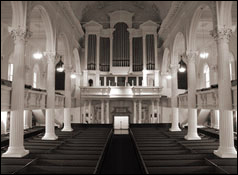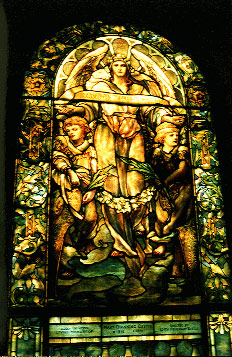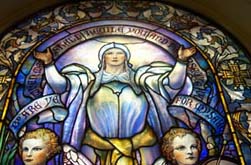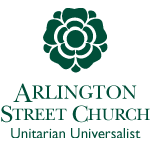About Us
Our Building
Tiffany Windows
- Learn more at Arlington Street Tiffany Center
Our Historic Building
 The present Arlington Street Church building was constructed between 1859–1861 on newly filled land in Boston’s Back Bay by members of the historic Federal Street Church. The original congregation gathered in 1729 in a barn where the Bank of Boston stands today on the corner of present-day Federal and Franklin Streets.
The present Arlington Street Church building was constructed between 1859–1861 on newly filled land in Boston’s Back Bay by members of the historic Federal Street Church. The original congregation gathered in 1729 in a barn where the Bank of Boston stands today on the corner of present-day Federal and Franklin Streets.
A statue of the Rev. William Ellery Channing, the great definer of Unitarianism and the fifth minister of this congregation from 1803–1842, is located across from the church in the Public Garden.
“We honor this historic building as the visible center of our belief. Our sanctuary exists for the gatherings of the larger community seeking open discourse. Our bells ring out for peace and justice.“
— from Arlington Street Church Covenant Statement
Construction
Arlington Street Church was the first public building in Boston’s Back Bay, a tidal basin of the Charles River that was filled in for building during the 1850s. Work began on Arlington Street Church in September, 1859. In May 1860 the cornerstone was laid at the southeast corner of the building. The 190 foot high spire was finished and the weathervane fixed in place on September 11, 1861. The building was dedicated on December 11, 1861.
The church rests on 999 wooden pilings driven into the mud of Boston’s former Back Bay. The pilings must remain submerged in water at all times so that they do not rot.
Exterior Architectural Design
The building was designed by the celebrated Boston architect, Arthur Gilman. He designed the exterior after the famous church of St. Martin in the Fields in London. The structure is sheathed in New Jersey brownstone ashlar and displays architectural embellishments derived from the Italian Renaissance and 18th century English sources.
Interior Architectural Design
The church’s interior design is of the Basilica type, the model on which most Italian churches were built. It is divided into a nave and two side aisles by a range of twenty-five foot high Corinthian columns set on plinths elevated to the height of the tops of the pews.
Ceiling
Above the columns are five arches designed after the church of the Annunziata at Genoa, Italy. The arches appear to spring from their mouldings at the capitals of the columns. The sixty two foot high ceiling forms a great curved vault over the nave. Ornamental plaster mouldings and panels feature foliage arrangements borrowed from classical French and Italian styles.
Floor Plan and Pews
The interior measures 65 by 90 feet and has 108 pews made of chestnut with black walnut rails. The two galleries have 48 additional pews. The church can seat 912 people.
Steeple Bells
The church has a set of 16 steeple bells that was given by Deacon Jonathan Phillips, a friend of the Reverend William Ellery Channing. The bells were restored in 1960 and played on Christmas Eve for the first time in many years. They are always played by hand.
Landmark
Arlington Street Church was listed in the National and State Registers of Historic Places in 1973 and designated a landmark in 1978 by the Boston Landmarks Commission.
Our Tiffany Memorial Windows
We are proud to share the resplendent beauty and history of our Tiffany stained glass windows with you. To learn more about our windows, visit Arlington Street Tiffany Center, a program of The Foundation for the Preservation of 20 Arlington Street.
Brief overview: The Tiffany windows in Arlington Street Church are famous for their beauty of design and execution and are believed to be the largest collection of Tiffany windows in any one church. They follow a general plan adopted in 1898 and were installed between 1898 and 1933.
The windows represent the highest development of American art in glass. Special Tiffany techniques were used, such as painting certain details and multiple layers of opalescent glass to achieve desired shades of color and Tiffany’s unique creation of folds and drapes.
The windows in the galleries, illustrative of the Beatitudes, were designed by Frederick Wilson. The windows on the main floor are from designs by different artists. All of the windows were made under the supervision of Mr. Louis Comfort Tiffany and Mr. Edward S. George.
Windows on the main floor
On the left facing the pulpit
Madonna of the Flowers
Installed 1899
Memorial to: Sarah C. Guild, 1831-1889
Donor: Curtis Guild
Message of the Angels to the Shepherds
Installed 1900
Memorial to: John Ball Brown and his wife, Rebecca Warren Brown
Donors: Their children, Abbie Collins Brown and Rebecca Warren Brown
The Annunciation
Installed 1900
Memorial: James L. Little, 1810-1889
Donor: John Mason Little
John the Baptist
Installed
Memorial: James H. Beal, 1823-1904
On the right facing the pulpit
Jesus and the Children
Installed 1903
Memorial: Horatio Hollis Hunnewell, 1810-1902
Donor: Mrs. Robert Gould Shaw
The Good Shepherd
Installed
Memorial: In Memoriam C.A.B. F.S.W.B. E.J.W.
Donor: Mrs. F.B. Greene
Sermon on the Mount
Installed 1902
Memorial: Matthew Luce
Donors: His friends
Jesus in the Temple
Installed 1903
Memorial: Henry Miles Knowles, 1850-1903
Donor:
Gallery windows
On the left facing the pulpit
Blessed are the Pure in Heart
Installed 1922
Memorial: Mary Channing Eustis, 1818-1891
Donor: Edith Hemenway Eustis
Rejoice and Be Exceedingly Glad
Installed 1922
Memorial: Henrietta M. Wigglesworth
Donor: Her daughter, Henrietta G. Fitz
So are ye when men shall revile you and persecute you for my sake
Installed 1929
Memorial: Hannah Thwing Osgood and Fanny Colburn Osgood
On the right facing the pulpit
Blessed are the Peacemakers
Installed
Memorial: Alexander Strong Wheeler
Donor:
Blessed are the Meek
Installed
Memorial: Rebecca Andrews Green, 1841-1905
Donor:
Blessed are the Merciful
Installed 1920
Memorial: Arthur Frederic Estabrook, 1847-1919
Donor: Mrs. Estabrook



